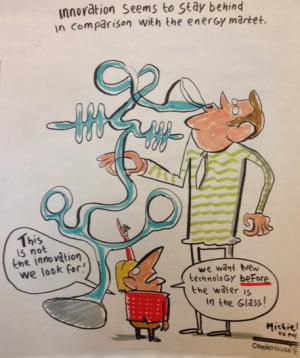A post reflecting on the theme of World Water Day: 'Affordability of public goods: why does energy outperform water?'
Published on: 25/03/2014
The theme of the Dutch celebration of World Water Day 2014, 'Affordability of public goods: why does energy outperform water?' made me wonder. In which sense is the energy sector outperforming water, can these sectors be compared and, if so, does this matter? This blog reflects on the theme and the discussions that took place during the event in Leeuwarden on 20 March.
In the keynote speech by Ben Knapen of the European Investment Bank, no figures were presented that showed the energy sector is more successful in attracting financing and the underlying reasons. But he suggested that 'the water sector needs to move from development to modern ways of working in order to address the gaps to innovation in the water sector.' I agree with Knapen. Yes, the water sector needs to professionalise. However, in which direction can innovative solutions to water service-related challenges be found?
Installing water, sanitation and hygiene hardware and infrastructure is not enough to ensure sustainable access to services. Innovation needs to come from a different way of working, which takes into accounts all aspects of running a service.
During the Dutch World Water Day, innovations were very much sought in applying new (Dutch) technology. I was hoping that the discussions would centre on the performance and affordability of the water sector and the service delivery models needed to ensure this. Despite billions of dollars being spent, one in three rural water supply systems in the developing world is not working at any given point of time. Water sector professionals know that simply installing water, sanitation and hygiene hardware and infrastructure is not enough to ensure sustainable access to services.
Innovation needs to come from a different way of working, one that takes into accounts all aspects of running a service. This includes models for managing the service, with different levels of private sector involvement and different contractual agreements; service monitoring and regulation; maintenance, repair and replacement of hardware; training and capacity development; policy making; and long-term financing of all aspects of providing services, not just capital expenditure. How to address the different problems in each of these aspects of running a service is the complex challenge we are facing in delivering sustainable and affordable water, sanitation and hygiene service for all.

For example, when it comes to service monitoring and regulation, clear and agreed indicators and systems to regularly collect and analyse this information at country level are often missing. Gerhard van den Top of Vitens Evidens International rightly stated (in the plenary discussion): 'Performance is the basis. You will not invest in increasing access water if performance is not good.' This is one of the problems in the water sector that needs innovation; measuring the performance and using this information to plan and manage water, sanitation and hygiene services.
In Ghana, IRC in the Triple S initiative is for example working with the Community Water and Sanitation Agency, responsible for rural water provision, to develop a system for monitoring rural and small town water services. This includes not only monitoring the functionality of water schemes, but also the level of service they provide and the performance of the service providers and service authorities, responsible for supporting service providers.
The discussions in the workshop on 'Policy and Finance' I attended focused on finding market-based solutions aiming for full cost recovery, modelling the energy sector. One of the participants suggested that profits made by businesses be redistributed through taxes in benefit of the poor. Yes, it is interesting to look at market-based solutions, but access to water (and sanitation) is a public good and a human right. Based on IRC's WASHCost work of identifying the life cycle costs of water, hygiene and sanitation services, market-based solutions aiming at full cost recovery do not seem realistic.
Market-based solutions aiming at full cost recovery do not seem realistic … public finance will always be needed to bring decent quality services to either the rural or urban poor.
As IRC's director Patrick Moriarty stated in one of his blogs; public finance will always be needed to bring decent quality services to either the rural or urban poor. This can be done through direct transfers from national government to service providers. Or with measures such as adding a surcharge to the water (and sewerage) bills of connected urban households to provide sanitation services to the unconnected urban poor, as was suggested by WSU's Guy Norman at the 2013 Stockholm World Water Week in the session on sanitation for the urban poor.
Sufficient expenditure on direct and indirect support are also essential for sustainable service delivery. For example, direct support is expenditure to support water and sanitation service delivery directed to service providers as well as to users or user groups. While indirect support refers to support to water and sanitation service delivery at national/institutional level, for example expenditures linked to the development of a national WASH policy. Based on WASHCost work, at least US$1 per person per year needs to be spend on direct support to ensure reliable service delivery (Smits et.al, 2011). Both expenditures are also commonly funded through public funding.
Unfortunately, the workshops and plenary discussions at World Water Day did not focus on service delivery models and the lessons to be learned from the energy sector. The questions therefore remain: 'Why do private investors prefer energy over the water and sanitation sector? What are the bottlenecks? And how do we overcome these?'
At IRC we have strong opinions and we value honest and frank discussion, so you won't be surprised to hear that not all the opinions on this site represent our official policy.